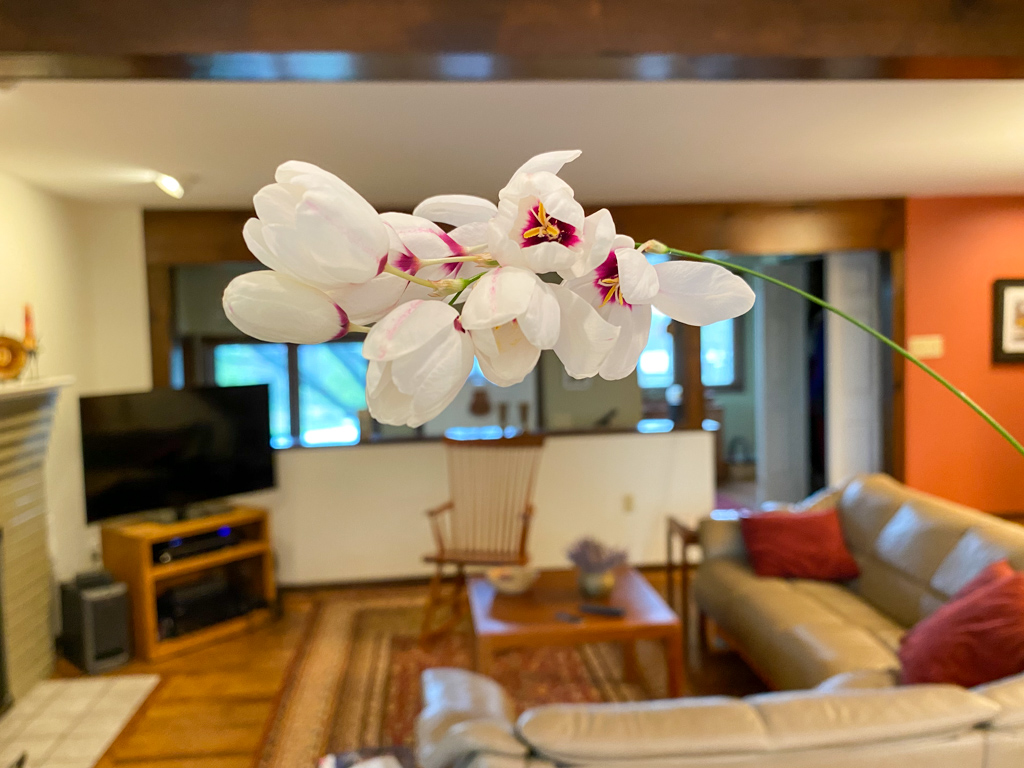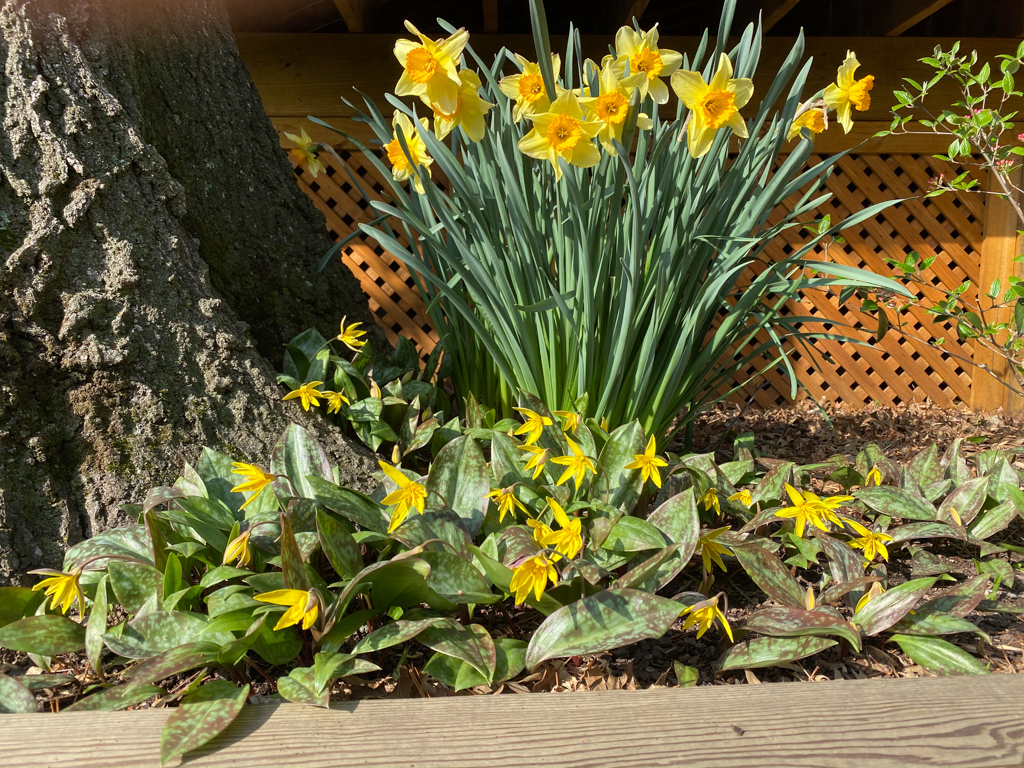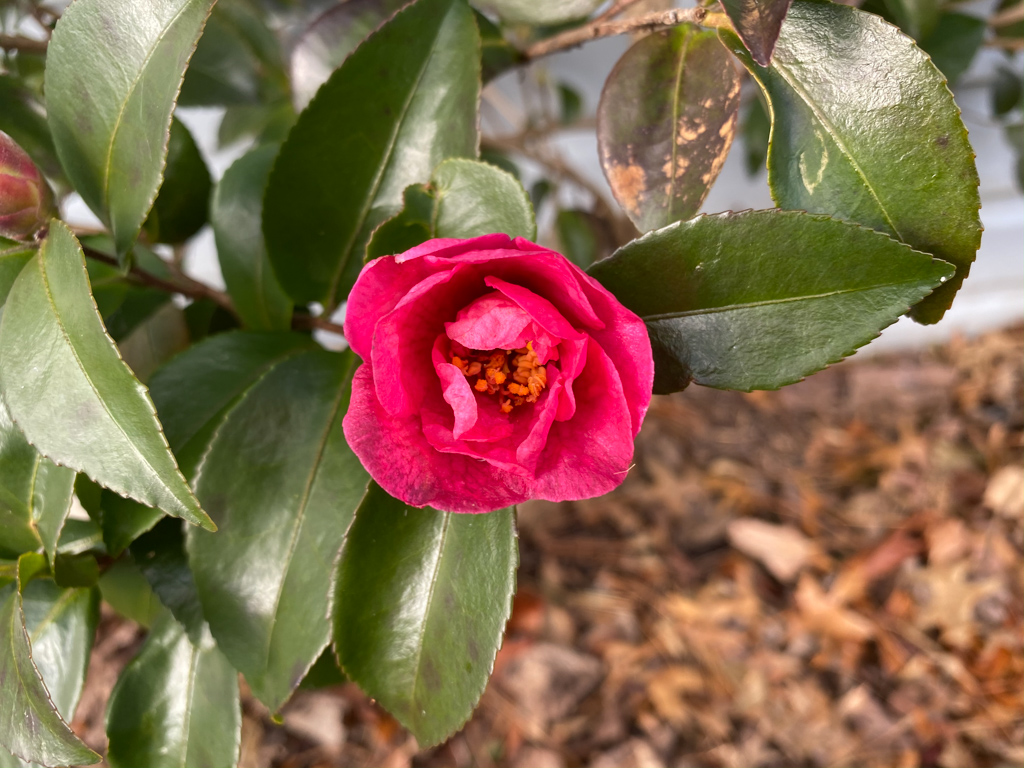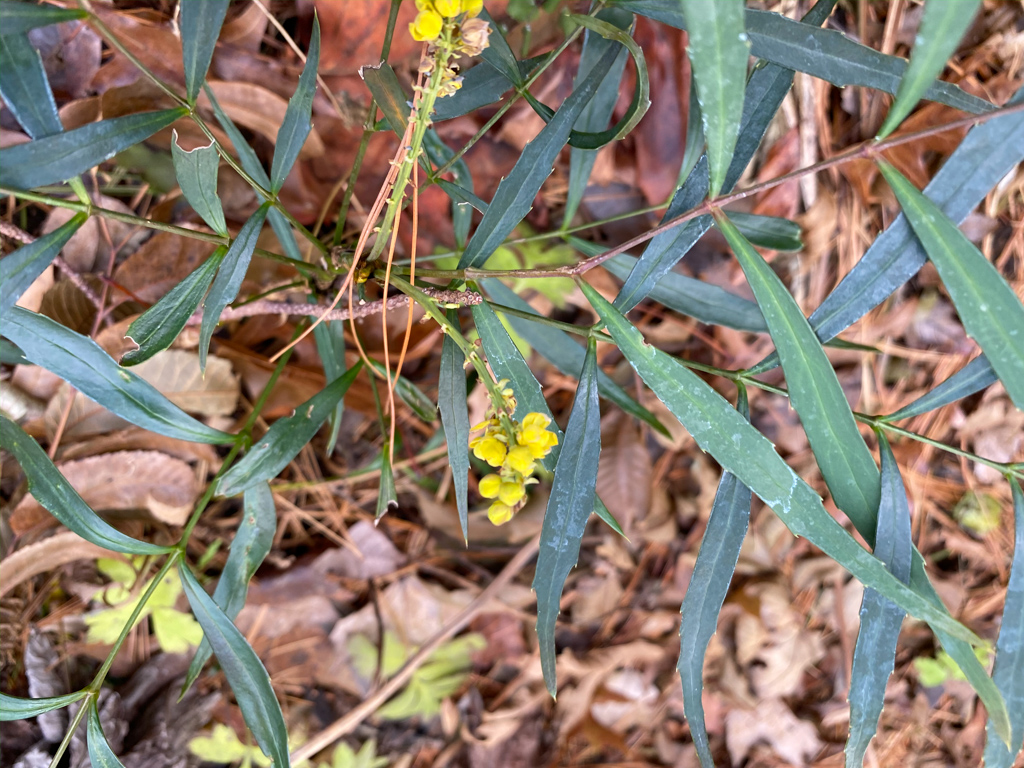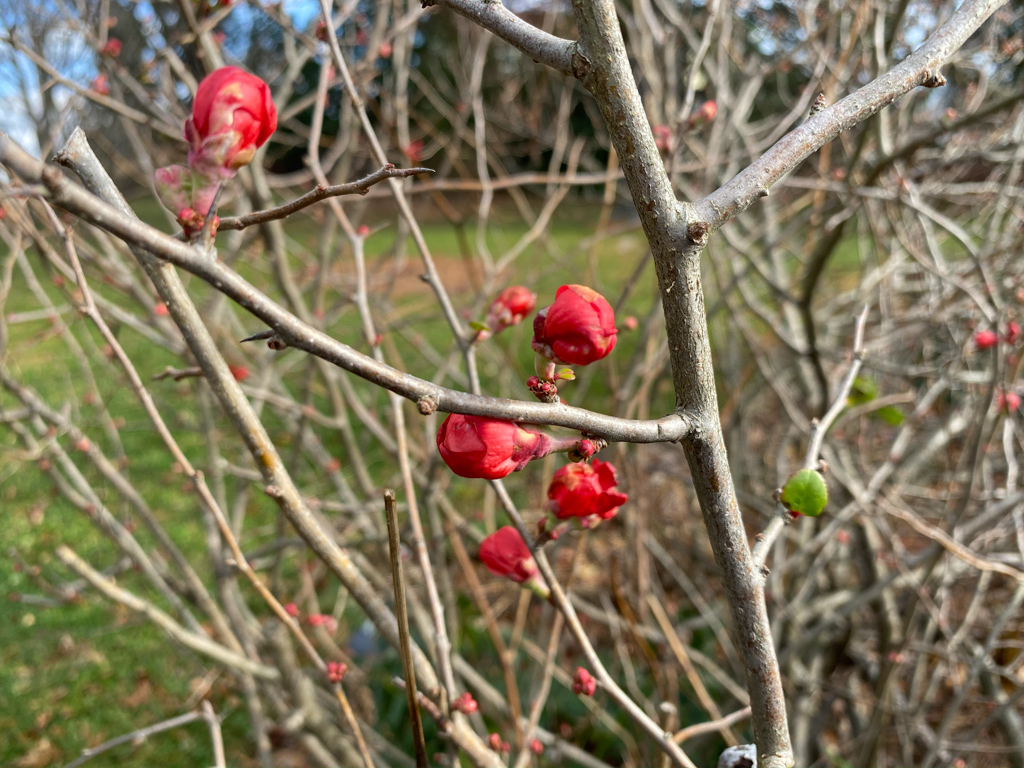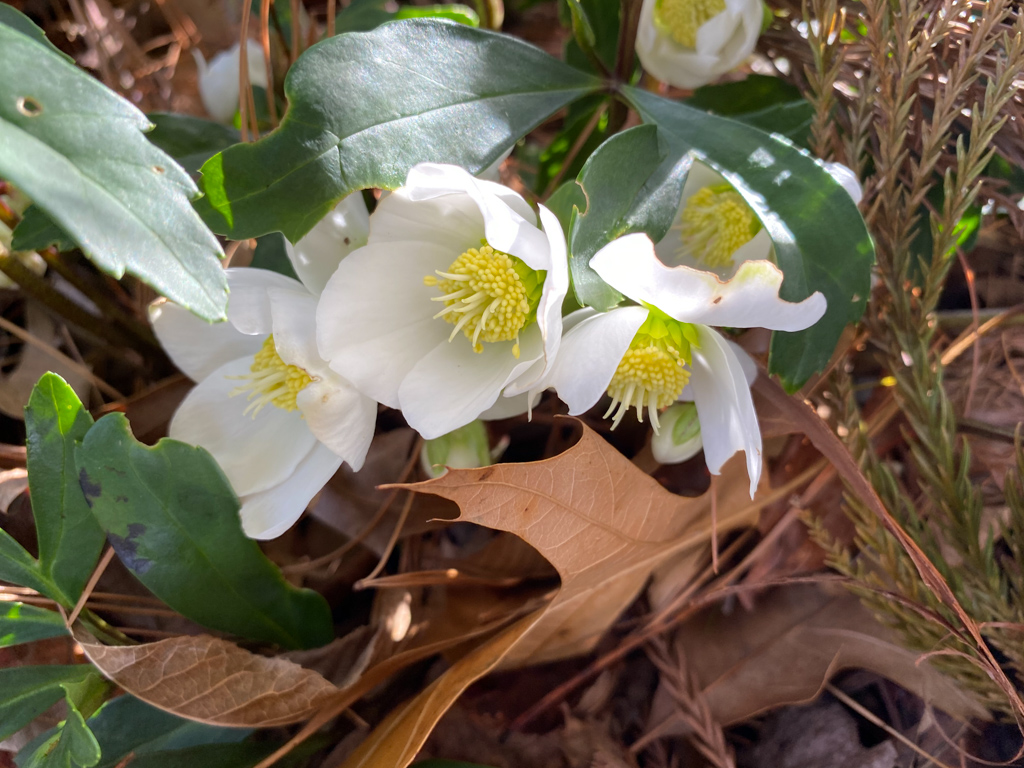
Helleborus niger ‘HGC Jacob’
Well it is December so it’s not surprising that the first Hellebore is blooming for Garden Blogger’s Bloom Day. Helleborus Niger is always well ahead of it’s compatriots in providing winter bloom. Nonetheless it’s still the camellias that are providing the most stunning flowers around our hillside.

Hybrid Fall Camellia

Hybrid Fall Camellia detail

Red Camellia sasanqua

Red Camellia japonica
The camellias are pretty consistently with us for the fall and then on again off again until into the springtime. More surprising is the heather that is blooming right now.

Kramer’s Rote Heather (Erica x darleyensis)
And there is also a little ice plant that is flowering way out of season.

Delosperma cooperi
You can see white tips on the snowdrops and the adonis are also coming into bud.

Adonis buds
But we are expecting 10 inches of snow tomorrow (the first real snow we’ve had this year), and that means the plants are likely to slow down for awhile.
In the greenhouse we have a number of early daffodils in bloom.

Narcissus cantabricus ‘Silver Palace’
And there is also the beautiful wavy-flowered Nerine undulata still flowering after more than a month of bloom.

Nerine undulata
We have put up our traditional live Christmas tree, this time a Canaan Fir.

Canaan Fir Christmas Tree
This will be planted out in the pasture after the holidays.
December 15th is also the first day for choosing seeds from the North American Rock Garden Society’s Seed Exchange. I was up early this morning (late last night) putting in my request for my 35 1st choice seed packets on the list. This is great fun and I would encourage everyone to get involved. There are 2480 taxa available including many rare and unusual varieties that you will not find from commercial sources.

NARGS Seed Exchange
Garden Blogger’s Bloom Day April 2020
It is a very flower-filled time for the GBBD post. Like everyone, we have flowers blooming everywhere and part of my dilemma is always where to focus my time and attention. The species peony shown above led me down an internet road trying to untangle the details of peonies with glabrous styles, purple anthers, and smooth undersides of leaves. On top of that it was just a lovely little peony that I cannot recall acquiring.
There are many other peonies, either flowering or about to flower. I have to admit that I am partial to the species peonies.
Nearby the Iris japonica are taking over their region of the garden.
These are definitely spreaders so you want to choose their location with care.
Similarly I’ve noticed how some of the anemones and primroses are happy to spread each year.
Thinking of spreaders, I have tried to move the Cascadian Wallflower from parts of the garden each year and it always finds a new place to make an appearance. But it’s so lovely it’s hard to not just appreciate it.
In addition an orange flowered wallflower reappeared from a wildflower mix that went in last year.
The yard as a whole is blessed by the things which happen in the mid-Atlantic April, like azaleas, viburnums, dogwood, and flowering fruit trees.
While out in the orchard, things are in extravagant bloom this year.
The Spitzenburg is one of the finest apples you will ever taste, but when you look at the trunk of this little guy you have to be grateful that it is producing any apples at all.
Hidden around the yard are still some smaller gems that i look forward to each year.
And when we go back to the troughs, the first Gentiana is showing up.
The alpine beds themselves are both chock full of interesting things like daphnes, stonecress, iris, poppies and the like.
Particularly noteworthy is a little Lewisia returning to claim its space.
and an Androsace which is always welcome.
As well as the always striking Bird’s Foot Violet.
In the greenhouse itself are still things which worth sharing or bringing into the house. The Ferrarias have been blooming since February.
Other South Africans include two Ixias, tritonias, and Ornithogalums.
And, of course, we continue to harvest daffodils from our years of planting.
Hoping this post finds the reader healthy and able to enjoy the spring.
Catching up with Spring
Spring has been rapidly moving onward in the mid-Atlantic. Bringing us, for one thing, the first flowering of a lovely peony above that we acquired from John Lonsdale two years ago.
We like the rest of society have been dutifully staying at home and, in our case, appreciating all the horticultural bounty that nature has to offer. This year many of the plants are well in advance of the norm. Although our nominal last frost date is 2-3 weeks from now the flowering fruit trees (even apples) are already in bloom. Especially bountiful are the blossoms on the Asian Pear.
Even the Kwanzan Cherry is fully in flower, fully two weeks ahead of last year.
I had the intent to track the progress of the garden a bit closer than usual, but I find myself jumping from one object to another as the plants keep popping up. Erythroniums are especially lovely in the spring, sort of a precursor to the larger lilies to follow. We have a raised bed by the deck that is crammed full of trout lilies (Erythronium americanum). This is what it looked like a week ago.
Many years I ago I dug some of these and moved them out to forest in multiple locations. Although the plants have succeeded marvelously in the woods, despite deer and other animals, they do not flower. They spread like mad but they seem to have no interest in flowering. So last year I thought I would inspire them by planting in their midst some horticultural cultivars which have always flowered in the yard (Erythronium ‘Pagoda’). And, indeed, they shot up lovely looking buds which the deer promptly chopped off. Perhaps the E. americanum are simply wiser than me and know that it would be foolish to flower in the forest.
In any case we still have Erythronium to enjoy in the yard.
Another spectacular genus to enjoy right now are the Epimediums. Beth was gifted with two Epimediums years ago that established large and lovely clumps at the back fence. Not only are the flowers lovely, but the leaves are beautiful in the own right.
Other Epimediums are well established in other parts of our garden.
Some more traditional parts of the garden probably include this very hardy and early azalea.
A spectacular little primrose hybrid.
Multiple trilliums such as the T. grandiflorum
Daphne at the front fence
And a new japanese quince that I received as a father’s day gift last year.
But gardens are not made with flowers alone. There are some special green things on their way right now. The little Pteridophyllum has the glossiest green, fern-like foliage at the start of the year.
Peltoboykinia comes from the high mountains of Japan but seems to be happy here in Maryland.
Multiple variants to may-apples are on their way.
And the first of the Arisaemas is on its way.
While i’m in the yard, I still need to mention the star flowers that have been a real pleasure this year. This little Ipheion has been flowering for weeks now.
As we go back to the Alpine bed there are a lot of flowers calling for attention
Two that always stand out are the Pulsatilla and the Armeria.
And at the greenhouse entrance is a trough with a delightful little Androsace that has been a regular participant in our springtimes.
But before I leave off posting for today, let’s take a walk to the forest, through the garden gate and past the very large wild cherry trees.
Our trail leads us past many clumps of daffodils that have been planted over the years, past scilla, toothwort, hepatica, anemone, muscari and bluebells
To a very special clump of daffodils with haunting green eyes.
Arguros is the Greek word for silver and seems appropriate for this treasure.
May this posting find you healthy and able to enjoy the world around you.
Eranthis and the Daily Walkabout
This is a wonderful time of year to watch the Winter Aconite (Eranthis hyemalis) emerge from their slumber. They spread every year — into the grass and other parts of the garden. But it’s a nice kind of spreading. Hardly any other plants are doing anything at this time of year and in six weeks from now they will have disappeared till next year. There are some other color forms of the winter aconite, either paler yellow or orange shades, but one of my strong desires has been to grow the white species, Eranthis Pinnatifida. I got one flowering a few years ago, but it didn’t stay with us. Nevertheless, the flower is so intriguing that I keep persisting. I ordered one from Japan last fall and got it planted out in December. I noticed on my daily stroll about the garden that It is growing but it looks like no flowers this year.
At the same time, and almost so small that i nearly missed it, I found a flowering Eranthis pinnatifida in a seeding pot that I had started in 2016 from seeds obtained from the NARGS seed exchange.
Not only was this little jewel growing but there was another little Eranthis in the same pot. So hope spring eternal someone once said.
The seed exchanges are a wonderful introduction to new plants that you will never see in a commercial catalog. My package from the Alpine Garden society arrived just this week.
But I have already started many seeds obtained from NARGS, the SRGC, and individual seed vendors.
Also in the greenhouse is the first of the Ferrarias to bloom this year.
Ferrarias are very easy to grow and easily one of the most unusual flowers you will ever set eyes on. The curls around the edge have a fractal quality to them.
I also just brought the first of many Scilla peruviana into the house to enjoy.
But getting back to the daily walkabout, I would be remiss not to note that many crocus and snowdrops are appearing around the yard.
And the first Primula is showing it’s flowers as well.
Like the Winter Aconite, these are happy to spread into the lawn.
A more unusual spotting from the walkabout was to see the first pink color in one of the Saxifrages in a trough.
This little jewel flowered in April last year.
And I also noticed in the alpine bed that one of the Callianthemums from Japan that I planted in December has a bud on it!
These plants are really hard to find in the U.S. and my thanks to Yuzawa Engei for the wonderful packing to get it here.
Garden Blogger’s Bloom Day February 2020
It’s been a strange winter so far for this Garden Bloggers report. No real snowfall and temperatures that have fallen to 20 degrees on occasion but have mostly been well above normal, even near records for some days. Total precipitation is about 50% above normal. The result is that many flowers are up earlier than usual but get blasted in between glorious flowerings. A case in point is the camellias which have had many flowers but then get browned off when the temperature dips.
On the whole we are just enjoying some our early spring flowers earlier than usual.
The Hellebores are particularly resilient at this time of year.
This is one of the nicest new hybrids.
Of course one also expects to see snowdrops at this time of year, but they are spreading nicely.
The first full flowering in the alpine bed is the Draba hispanica.
In the greenhouse the Cyrtanthus breviflorus and mackenii are flowering.
And our only Geissorhiza is in flower too.
Finally we made two trips to Gettysburg Gardens where I discovered some lovely examples of Veldtheimia bracteata.
These are magnificent plants, sometime called forest lilies, that can easily grow to 2 ft tall with long lasting flowers.
Garden Blogger’s Bloom Day January 2020
Ok, I’ve just counted and I’ve done 400 posts already. That’s a lot of flowers no matter how I add it up.
It’s hard not to lead off this Garden Blogger’s Bloom Day with this stunning Camellia Japonica which has been flowering since November. It probably has 20 blooms on it at this point. Although I expect they will get burnt off with the next hard freeze, it has been a pleasure to see this one flowering on a daily basis with the very mild winter we have had thus far.
Similarly the red Japanese quince is getting ahead of itself.
The Hellebores are less surprising. The niger types are often in flower during any warm spell.
What was a surprise was to see this new pink hybrid also in flower.
This was new acquisition from Plant Delights. It’s been flowering for almost 2 weeks now.
The various snowdrops are up and doing what snowdrops are meant to do.
The yellow witch hazel (Arnold’s Promise) is also in flower but it was too windy to get good photos today. The Adonis are popping up and getting ready to bloom.
The biggest surprise from the outdoor flowers is this little Lewisia in the Alpine bed.
In the greenhouse we have many oxalis and narcissus blooming.
A little more surprising is this Silene that I grew from seed obtained through the North American Rock Garden Society’s seed exchange last year.
It really wanted to be outside but I forgot to plant it out last year.
We made a visit to Gettysburg Gardens last weekend and I brought back a number of treasures including this ground cover
And finally let me close with this lovely hybrid cyrtanthus that I found there.
Garden Blogger’s Bloom Day December 2019
Well this GBBD posting is almost like an advertisement for camellias. The winter has been very mild so far and not only are the fall camellias doing what they are supposed to do, but the spring camellias are getting into the act too.
In addition I found this morning, for the first time, a bloom on a camellia japonica x sasanqua hybrid that we have been growing for several years.
There aren’t a lot of other flowers out for December so the camellias really steal the show. Here are few things I noticed.
The greenhouse has a few things to put forward besides the oxalis which continue to bloom
And the very first narcissus of the season
April Delights
There are so many things happening in the yard right now that it is difficult to keep track of them all. I feel light the perennial puppy dog jumping from one delightful surprise to the other. To begin with the daffodils are exploding in the yard, on the hillside, and in the forest. It seems like a particularly bountiful year for these stellar performers that get ignored by browsing animals.
And the big Magnolia Stellata is fully in bloom
The Hellebores are everywhere with their spectacular but mostly downward facing blooms
But what really engages me in the spring are the smaller ephemerals that mostly have short but lovely blooming cycle.
One of my favorite Corydalis is ‘Beth Evans’
It was delightful to see that not only has this Corydalis seeded itself into the neighboring pathway but it’s also 15 feet away under the holly tree.
I was somewhat surprised that a couple of the Adonis are coming up much later than their brethren.
And my favorite, Adonis amurensis Sandanzaki, is only just now coming into bud.
The alpine beds and troughs also have some early spring flowers in bloom.
This little Burnt Candytuft was planted in tufa, but has jumped ship and is appearing in various places in the alpine bed.
Nearby is a really nice little sea thrift obligingly staying put on the tufa.
Nearby is a very early blooming Lewisia
Two years ago I acquired a nice little Draba from Oliver nurseries that is forming a nice compact mound.
A surprise to me this year was a little Saxifrage that came from Wrightman’s Alpines two years ago.
It’s growing in a very protected location on the shady side of an eastern-facing trough and if it flowered last year I totally missed it.
I shouldn’t ignore the greenhouse which continues to produces some South African gem every week. The latest is a 2 1/2 foot tall Ixia that came from the Pacific Bulb Society last fall.
I would be remiss if I did not mention the Edgeworthia by the front road.
It seems they are much hardier in Maryland than I expected.
Finally I need to share an example of the Camellias which also prove to be much hardier than one should really anticipate.
Now it’s time to go out into the yard and see what else is blooming.


























